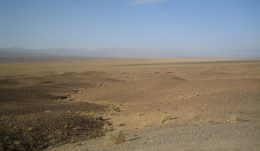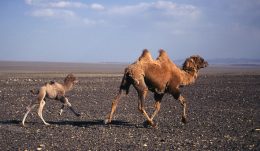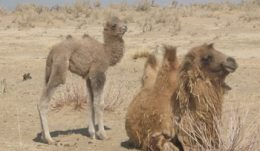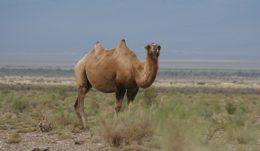- Locations: Great Gobi Strictly Protected Area, Park A in southwestern Mongolia
- Active dates: 2007 - 2010
Aims
To enforce protection of the wild camel's habitat in Great Gobi A Special Protected Area, Mongolia, and work with local communities to reduce their impact on wild camels and their habitat.
Species
Background
The wild camel only occurs in a few fragmented populations in northwest China and southwest Mongolia. This two-humped camel is superbly adapted to the harsh Gobi Desert, where vegetation is sparse, water sources are limited and temperatures range from -40°C to 40°C. Individuals eat thorns and dry, salty plants, which other herbivores avoid. They can go for several days at a time without nourishment, and when accessing a water source, can drink up to 57 litres in one go. Wild camels and their relatives differ from all other mammals because they have oval-shaped (instead of circular) red blood cells. They produce a protein in their milk that may be used to treat diabetes in humans, and they’re the only land mammals that can drink salty or brackish water, apparently with no ill effects.
Actions
EDGE has supported two Fellows to collect information on the relative impacts of habitat loss, hunting, hybridisation with domestic camels, poisoning and drought on wild camels in Lop Nur National Nature Reserve, China, and Great Gobi Special Protected Area A in Mongolia. The information collected is informing the development of a long-term conservation strategy that will provide benefits to both the wild camels and the human inhabitants of the harsh desert ecosystem.
Gallery



Achievements
Status review carried out for wild camels in Mongolia
Stakeholder workshop to develop the first conservation strategy for the wild camel in Mongolia
Associated Fellows
Collaborators and Supporters
Related blog posts

Monitoring of Wild Bactrian camels
Our Mongolian EDGE Fellow Adiya has just sent us a blog on the project he has been working on in collaboration with researchers from the Denver…

Surveying wild Bactrian camels in China
Yuanlei, our Chinese EDGE Fellow, recently sent us this update of his work on the Critically Endangered Bactrian camel, just before he headed out…

A Step Closer to China's Wild Camels
Yuan Lei is currently preparing to go into the field to begin his research into the main threats facing the wild Bactrian camel population…

Bactrian camel update – Field expedition to Gobi B
Adiya is our Mongolian EDGE Fellow studying the wild Bactrian camel. From the 19th to 28th April this year he went on an expedition…

Great Gobi protected area & buffer zone survey
Adiya Yadamsuren, our Mongolian Bactrian camel EDGE Fellow has just completed his surveys in the Buffer Zone of the Great Gobi Protected Area A in…

Four Bactrian camel calves born
Earlier this year our Mongolian EDGE Fellow working on the Bactrian camel, Adiya, and John Hare from the Wild Camel Protection Foundation (WCPF) visited…



